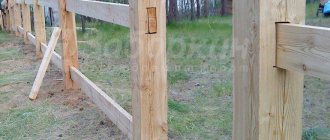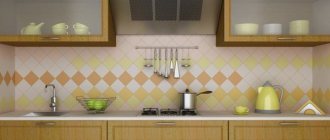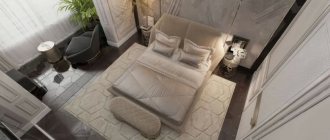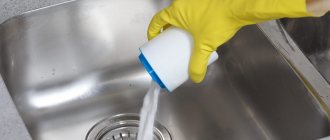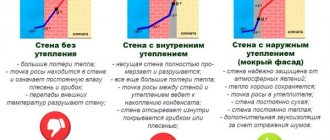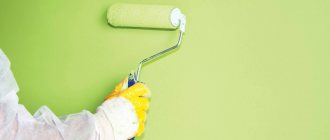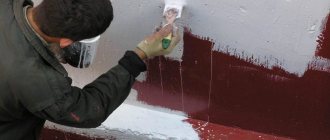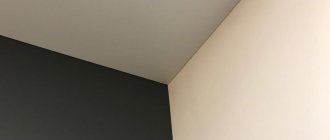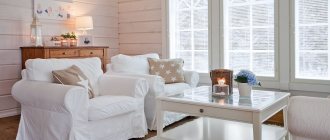Painting mesh is considered a convenient auxiliary material for installation of finishing and cosmetic repairs. It is used as a reinforcing base for putty, plaster, and paint. Why carefully level the surface if a mesh fabric does an excellent job of this function. Manufacturers offer a choice of rolls of different heights, cell size and fiber thickness vary.
Where is cement-lime plaster used?
Cement-lime mixtures are used not only for plastering residential premises - depending on the composition and ratio of the main components, they can be used to level walls in public, commercial and even industrial buildings.
Interesting materials:
What temperature can tomatoes withstand? What temperature can tomatoes withstand in a greenhouse? What greens can be planted next to tomatoes? When and how to plant tomatoes? When and how to properly plant and pinch tomatoes? When is the best time to spray tomatoes? When is the best time to pick tomatoes? When is it better to plant tomatoes in the morning or evening? When is the best time to sow tomatoes and peppers? When is the best time to sow tomatoes?
Application of painting mesh
To smooth out small defects it is difficult to find a more convenient material than fiberglass mesh. From filled cells it is enough to remove all unnecessary things. Any building mixtures can be applied to fiberglass: putty, plaster mortar, decorative finishes of different viscosities. Fiberglass mesh compacts mixtures and reinforces the adhesive layer when laying tiles.
The work process is greatly simplified. Wall putty with mesh is a good choice for renovations in a new building; they cover window and door frames with stripes, reinforce cracks, and cover joints. With the help of a mesh base it is convenient to align the corners; the material is laid when pouring concrete, when making a floor screed.
The mesh base makes it easy to align corners.
Procedure for sticking serpyanka
The mesh for painting walls got its name for its similarity to a coarse homespun row. Narrow stripes are often used for work. For repairs, it is better to choose self-adhesive materials packaged in small rolls. Thanks to the adhesive layer, the fibers are well retained on the surface.
The strips need to be glued onto a primer. A thin layer is sufficient. Strips strengthen cracks and mask butt seams. The tape is applied to the wet putty, leveled, then another layer is applied on top to fill the cells.
Before gluing, cracks are first cut with a trowel or knife and filled with putty. Deep cracks must be thoroughly dried before finishing sealing.
During installation, the tape should be completely stuck in the first layer of putty. The second one is applied after the first one has dried. Finishing puttying begins when the mesh adheres securely to the wall. When small cracks appear under the mesh on a concrete wall, the material keeps the finishing layer from falling off. Thanks to the cellular structure, it is possible to increase the intervals between cosmetic repairs. The reinforcing layer perfectly masks small irregularities and small chips.
The strips need to be glued onto a primer.
Wide fiberglass mesh
The plaster layer is laid more evenly on the substrate and does not peel off when dry. The mesh is glued to PVA or other waterproof adhesive used to fix light finishing materials:
wallpaper glue for non-woven base; gel for gluing foam ceiling profiles.
When using putty over a mesh, the consumption of putty mixtures is reduced, the composition is applied in a thin layer, and is easily leveled.
The fiberglass mesh for painting is pre-cut to the required format. During installation, the pieces are carefully aligned and stretched on all sides. Be sure to let the glue dry to avoid shifting the mesh while applying the putty.
The fiberglass mesh for painting is pre-cut to the required format.
During plastering work, the reinforcing mesh is evenly tumbled into the first layer; it is made up to 2 mm thick. The main condition is that the painting mesh does not touch the wall, then the adhesion will be reliable.
For finishing facades, meshes made of thick fibers are chosen. The size of the cells does not play a special role; the thickness of the reinforcing base is of real importance.
For finishing facades, meshes made of thick fibers are chosen.
Fiberglass web
Unlike woven mesh fabrics, the spider web mesh for putty has a random structure. The fiber is pressed like paper, called gossamer because of its thinness, the fibers are visible through light. The surface of the canvas is silky, perfectly smooth. The web firmly holds the finishing coat layer and prevents it from cracking under load. In new buildings, the main problem is shrinkage. After a year or two, cracks appear in the finish. When using fiberglass, damage can be avoided.
The web firmly holds the finishing coat layer and prevents it from cracking under load.
The non-woven material is fixed to the walls and ceiling using an adhesive composition; the adhesive is applied in a thin layer and is quickly absorbed. The canvas can be glued in whole strips along the entire length of the surface to be treated. The web is smoothed out first with your hands, then with a spatula so that it lays evenly, without swelling along the folds. The corner of the room should coincide with the corner of the reinforcing canvas. It is recommended to paste ceilings along the long side of the room, regardless of the location of the window. The canvas will not be visible under a layer of paint.
Fiberglass soaked in glue darkens. When the sheet is securely glued, cut off all excess, nothing should stick out or hang down. The next strip is fixed with an overlap of 3 cm, the joints are carefully creased. When the adhesive dries, the canvas will become lighter. You can start painting.
Fiberglass has a back and front side that can be distinguished by touch. The smoother and shiny one should be on the outside, the rough one is glued to concrete, drywall or other surfaces.
The non-woven material is fixed to the walls and ceiling using an adhesive composition.
When finishing walls and ceilings, putty mesh and non-woven fiberglass essentially perform the same function: they hold building mixtures on the surface and improve the adhesion of coatings to the substrate. Mesh materials will help make high-quality repairs and help avoid cracks during shrinkage of new buildings.
Work progress
If everything is understood correctly, then the work itself will not present significant difficulties.
The pattern we are aiming for
When performing the work, the final result will be the following simple multilayer structure:
- A – aerated concrete block;
- B – reinforcement, you can’t do without it, despite the increased strength of the blocks;
Here is a simple layer structure that you should strive for when finishing aerated concrete blocks (see description in the text)
- C is a special adhesive composition for aerated concrete, by no means an ordinary cement mortar;
- D – plaster on a possible primer.
Plastering aerated concrete
All work is done as follows:
- first, thoroughly clean all the seams between the blocks to a depth of 1 to 4 mm; the main thing here is to eliminate any unreliability in the masonry;
- then thoroughly clean everything from dust, including with a damp rag;
- let the surface dry completely;
Preparing the base
If you carry out this step conscientiously, you will protect the plaster layer from the formation of cracks. Preparatory work includes:
- Removing stains of grease, dirt, mastics.
- Cleaning from dust. To do this, use a damp brush, roller or rag. The tool must be used in the same way as when applying a primer.
- Removing excess mortar if it remains in the seam area. To do this, use an Aeroc aerated concrete trowel, TRV or its analogues. By the way, it is better to remove excess mortar at the construction stage, while the glue is still wet.
Technology
This technology itself is not very new: in old houses, especially wooden ones, you can often find walls covered with a lattice of thin wooden planks, on top of which plaster has already been applied. Now the choice of materials is much richer; it is not limited solely to wood.
Problems solved by reinforcement:
- The adhesion of the plaster solution increases.
- The coating becomes stronger. Having hardened in a single layer, the plaster turns into a monolithic layer.
- This method helps to some extent correct the master’s flaws. Even with an ineptly applied mortar, the reinforcing mesh will hold the plaster, preventing it from crumbling (read what to do if the plaster begins to crack and crumble here).
When to start finishing aerated concrete walls
The main distinguishing feature of aerated concrete is its increased hygroscopicity. Moreover, if the structure gets wet, when the temperature is above zero, negative consequences can be avoided - it will simply dry out, everything will be fine, but if water gets into the pores of the stone in winter, it freezes, accordingly, it expands, and cracks may appear.
Considering this, it would seem that the sooner the walls are plastered, the better. But this approach is wrong. It is ideal to carry out these activities for the next season, when the surfaces are completely dry after laying. Drying time depends on what mortar was used for laying. For example, a seam made with a concrete-sand mixture will take longer to dry than where the adhesive mixture was used, since it is much thicker.
Plastering is recommended for the next season
Another condition for finishing walls made of aerated concrete, which is recommended to be observed to achieve a high-quality result, is the need to do everything in warm weather. Experts call the optimal time March-October, when the air temperature is above zero. If this is not possible, it is necessary to at least coat the stone with a primer and cover it with plastic film, so that it will stand without losing its properties until it is completely finished. A deep penetration primer will most effectively reduce water absorption.
But sometimes there is no opportunity to postpone finishing work - it is necessary to carry it out immediately after the completion of the construction of the walls of the building. Here experts recommend paying especially close attention to the composition of the solution. It must have good plasticity and vapor permeability, then moisture can escape freely.
Applying primer
The primer increases the adhesion of other building mixtures to the base, and also protects the base from high humidity. Be sure to buy primers with antifungal, antiseptic and waterproofing effects. Remember that you are working with aerated concrete, which is vulnerable to moisture. A primer with such properties will protect the walls from the formation of fungus and mold. This is especially important for rooms with high humidity or for facades.
Apply the primer with a brush or roller in a dense layer. You cannot dilute the soil with water, because it will lose its properties.
When the primer has dried, proceed to installing the façade mesh.
Features of the chain link
The most popular of all metal analogues. Made from carbon, high-alloy or galvanized steel wire, which is often coated with a polymer. A product with PVC coating is more durable because it does not rust and can withstand environmental influences. Usually fences are made from chain-link.
It is made by twisting wire with a diameter of 1-3 mm into a spiral, from which the entire fabric is then woven. Chain-link is often used to cover adobe or clay walls before plastering them. The reinforcing relief layer that the mesh creates is capable of holding a lot of plaster. The thicker this layer, the larger the cells should be.
How to plaster aerated concrete inside a house
Plaster containing sand is not used for finishing aerated concrete. Due to their high density, such mixtures do not adhere well to the plane of the block; over time, such a layer of plaster will peel off or become deformed.
The protective layer on the aerated concrete block must be resistant to temperature changes, sufficiently dense, and have good vapor permeability; ensure reliable adhesion, increase thermal insulation, and prevent cracking. It serves as the basis for further finishing.
Internal aerated concrete plaster should:
- be plastic, this will allow it to be evenly distributed over a smooth area of the wall;
- be moderately liquid so that the material does not slide from top to bottom;
- ensure the required level of moisture permeability and maintain the thermal insulation properties of aerated concrete blocks.
Therefore, dry gypsum mixtures are used for interior work.
Which plaster to choose for wet rooms
The bathroom, toilet, kitchen are characterized by high humidity. How can you plaster a gas block in such rooms inside the house? It is necessary to use plaster with the addition of cement; it is not afraid of high humidity, it becomes stronger by absorbing steam. But in such places it is necessary to provide good forced ventilation to remove moist air to the street.
Plastering of aerated concrete walls indoors with cement mixtures is applied to a limited extent, since they have low water permeability and do not allow moisture to penetrate through its layer to the outside. For wet rooms, dry cement mixture Ceresit and others are produced.
For living rooms
Plastering aerated concrete walls indoors can be made using minerals to maintain steam permeability. The Knauf company produces Rotband gypsum plaster with the addition of perlite sand to prepare surfaces for final finishing. Rotbunt contains an adhesive component, which ensures adhesion of surfaces.
What is the vapor permeability of aerated concrete.
The ability to establish processes of release - reception of excess humidity from the external atmosphere, and the internal microclimate of the house, is called - Vapor permeability. The importance of this parameter cannot be relegated to the background. Therefore, you should approach the selection of aerated concrete plaster for interior decoration and exterior work with special responsibility.
There are many tables on the Internet in which all the necessary numbers can be examined in detail and applied to yourself.
Vapor permeability is also called “breathing” of walls. If “breathing” is impaired, then consequences appear:
- cracks inside and on the external facade of the building;
- the appearance of traces of masonry in rain or fog;
- increased humidity in the room;
- mold growth in the corners of rooms.
Do not confuse aerated concrete with foam concrete.
Despite the external similarity, these are completely different materials, the properties of which are very different. In the structure of foam concrete, air bubbles do not connect, which contributes to its increased resistance to getting wet. As a result, the qualities of thermal conductivity and frost resistance increase.
While in aerated concrete these bubbles are interconnected, moisture can move freely through them, giving off heat or freezing from frost. Therefore, plastering aerated concrete walls indoors and outside on the facade of the house is important.
What plaster is suitable for aerated concrete in a residential area?
For residential premises, it is usually recommended to use gypsum plasters. This material is vapor permeable, which maintains an optimal degree of humidity indoors. But with standard ventilation, vapor permeability for aerated concrete is not so important. Excess moisture easily escapes through the ventilation holes. “Breathing” walls are more of a cunning marketing ploy. With a normal ventilation system in the room and without the participation of walls, natural humidity is maintained.
Gypsum plaster is also distinguished by its cost-effectiveness and ease of installation. Gas silicate has an ideal geometric shape. Thanks to this feature, the walls are perfectly smooth and without pronounced defects, and do not require additional leveling.
If the home owner wants to leave aerated concrete walls completely vapor-permeable, then it is worth choosing a finishing material in the form of textile or non-woven wallpaper. It is worth noting that heavy vinyl wallpaper is not recommended for use in this case. They are not vapor permeable.
What and how to plaster aerated concrete
Due to their lightness and thermal insulation characteristics, cellular concrete blocks are successfully used for private and civil construction.
A type of such material is aerated concrete. It consists of a cement-sand mortar, and the cellular structure is achieved by introducing a gas-forming agent into the composition. The peculiarity of such a block is a high degree of fire resistance, ease of processing, environmental friendliness and durability. It is used for load-bearing enclosing structures and for partitions. What plaster is best for plastering aerated concrete walls? To answer the question, let’s look at what types of plaster mixtures there are.
Types of material
The times when only shingles were available are long gone. Nowadays you can find many types of reinforcing materials on the building materials market. Let's figure out what they are and when they are used.
Fiberglass
Used for facade finishing. Properties:
- Withstands heavy loads.
- Not subject to corrosion.
- They are chemically resistant, so you can use any plastering compositions.
However, they can well be used when plastering interior spaces.
Polymer
This is the most common plastic material. Advantages:
- They are universal and can be used for interior or facade decoration.
- Lightweight, do not require reinforced fastening. They can be planted even on a thin layer of mortar, and then the rest of the plaster can be applied.
- Environmentally friendly.
Disadvantage: low strength. It is difficult to maintain a layer thicker than 6–8 mm on the polymer. Therefore, they are used only where it is planned to use light compounds applied in a thin layer.
Attention
The general techniques for working with plastic and fiberglass are the same, so in the future they will be considered together.
Metal
Metal mesh is commonly used for exterior plastering . They are knitted from galvanized wire to avoid corrosion. There are varieties used for interior decoration.
The main advantage of metal as a material for reinforcement is its strength: it holds even a thick plaster layer well.
The following types are used for finishing:
- Woven . This material is similar to fabric and consists of thin wire threads intertwined, as in fabric. Suitable for exterior and interior decoration.
- Chainlink. Used for plastering large surfaces.
- Welded. Transverse and longitudinal rods are fastened with electric spot welding. Used for exterior finishing where it is necessary to hold a large mass of mortar.
- Expanded metal . A sheet of thin metal is taken, and many small cells (usually diamond-shaped) are cut into it. It holds well a thin layer of mortar that needs to be strengthened.
The main advantage of metal mesh is the ability to create a flat surface even with strong unevenness on the base. Metal allows you to correct unevenness even 4–5 cm in size. Metal mesh, especially coated with zinc, is chemically inert and holds even aggressive cement-sand composition perfectly.
Important
Metal mesh is the strongest among all reinforcement materials.
